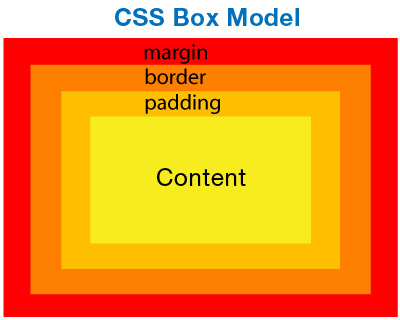CSS Box Model
| « Previous | Next Chapter » |
The CSS Box Model
All HTML elements can be considered as boxes. In CSS, the term "box model" is used when talking about design and layout.
The CSS box model is essentially a box that wraps around HTML elements, and it consists of: margins, borders, padding, and the actual content.
The box model allows us to place a border around elements and space elements in relation to other elements.
The image below illustrates the box model:

Explanation of the different parts:
- Margin - Clears an area around the border. The margin does not have a background color, it is completely transparent
- Border - A border that goes around the padding and content. The border is affected by the background color of the box
- Padding - Clears an area around the content. The padding is affected by the background color of the box
- Content - The content of the box, where text and images appear
In order to set the width and height of an element correctly in all browsers, you need to know how the box model works.
Width and Height of an Element
Important: When you specify the width and height properties of an element with CSS, you are just setting the width and height of the content area. To know the full size of the element, you must also add the padding, border and margin.
The total width of the element in the example below is 300px:
| width:250px;
padding:10px; border:5px solid gray; margin:10px; |
Let's do the math:
250px (width)
+ 20px (left and right padding)
+ 10px (left and right border)
+ 20px (left and right margin)
= 300px
Imagine that you only had 250px of space. Let's make an element with a total width of 250px:
Example
Try it yourself » |
The total width of an element should always be calculated like this:
Total element width = width + left padding + right padding + left border + right border + left margin + right margin
The total height of an element should always be calculated like this:
Total element height = height + top padding + bottom padding + top border + bottom border + top margin + bottom margin
Browsers Compatibility Issue
If you tested the previous example in Internet Explorer, you saw that the total width was not exactly 250px.
IE includes padding and border in the width, when the width property is set, unless a DOCTYPE is declared.
To fix this problem, just add a DOCTYPE to the code:
Example
Try it yourself » |
| « Previous | Next Chapter » |